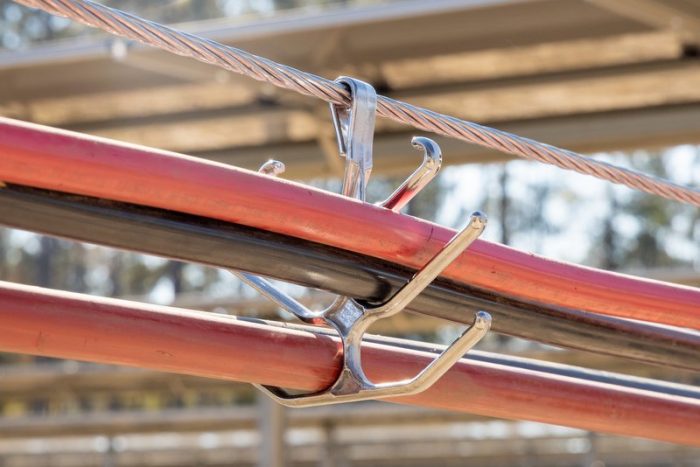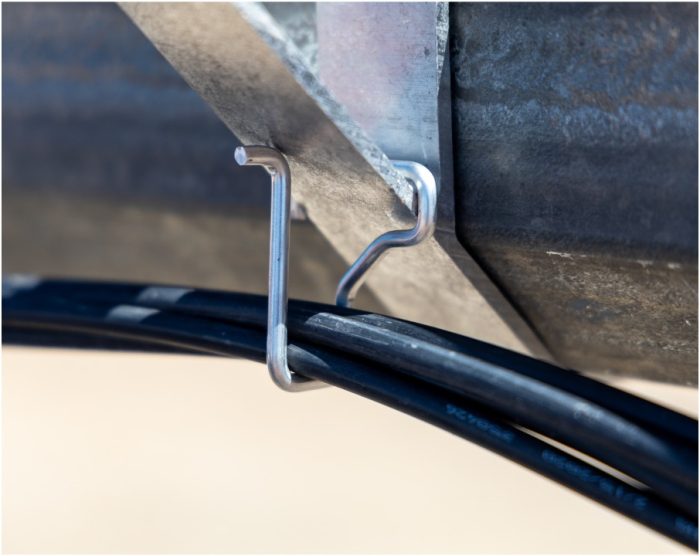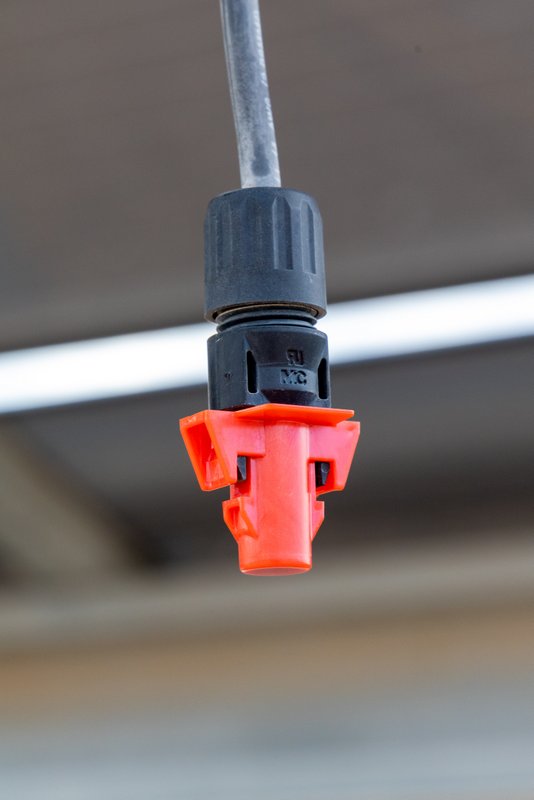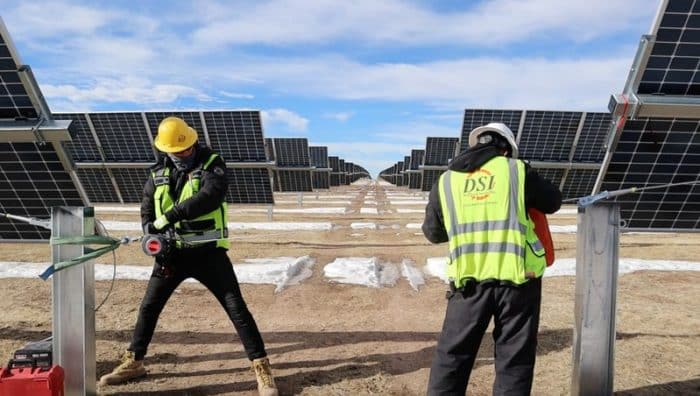
Affordable Wire Management (AWM) was founded by three engineers who believed new product options were needed in large scale wire and cable management. CEO Scott Rand (formerly with Merit Controls and First Solar) and CTO Dan Smith (formerly with Array and First Solar) got the ball rolling in 2020, and Peter Hruby (formerly with First Solar and Kinematics) joined in 2021 as CTO.
All three worked for several years in the construction EPC side of the solar industry and saw that wire and cable management “just wasn’t a priority because the actual CapEX as a percentage of the overall plan is relatively low compared to inverters, trackers, and modules, which make up the largest percentage,” Rand surmises.
This mindset led to a status quo of plastic or plastic-coated metal components. This is what the AWM trifecta initially set out to change.
“We really saw solutions currently on the market as being insufficient for the requirements of these solar projects, which now are exceeding 35-, 40-, 45-year lifetimes in the models,” Rand says. “From an initial CapEX perspective, metal hangers might seem a bit more expensive, but the business case moves to metal components the first time you have to replace a plastic component.”
Cut to 2024, and that status quo has definitely changed. Some EPC contracts actually restrict plastic for managing wire components now. The status quo has significantly changed for AWM too. Metal focus aside, AWM continued to refine its initial designs to not just solve their initial EPC pet peeves, but also to facilitate mass production. AWM is now able to pump out 100+ GWs of cable hangers annually for utility-scale solar power plants.
We recently caught up with Rand to discuss how cable hangers impact solar project designs, and how recent AWM updates have enhanced their ability to supply U.S. utility-scale solar.
Crowell: Getting a new product into utility-scale solar projects is not easy because of long-term established partnerships and the manufacturing scale needed to support demand. But you all have made a dent since you launched. How did 2023 close out?
Rand: “We have. In 2021, we installed just over 1.3 GW. In 2022, we installed just over 2 GW. And in 2023, we did about 6 GW. In all, we have deployed 8+ GW throughout North America. And, we’re currently working with eight out of the top ten EPCs.”
Crowell: In those numbers, how many are new projects versus existing projects that are in need of upgrades or product replacements?
Rand: “Our Arden Messenger Cable Hangers and Bonsai Module Cable Hangers are primarily used in new projects. That being said, we get a lot of opportunities to support owners that have taken over power plants and are looking for a longer life solution, relative to what they were given. We’ve worked with customers like SOLV, NovaSource, and AES to support some of these retrofits.”
Crowell: So, when we say “metal” hangers, we’re talking about aluminum. Are there any concerns about aluminum supply chains or pricing going forward? Or maybe domestic supply vs. imported supply?
Rand: “Our products are primarily aluminum. There’s a lot of cable that’s made in the U.S. primarily of aluminum, so we don’t currently see any supply chain constraints. From the beginning, we have been dedicated to domestic manufacturing, and that has extended to sourcing American-made components. In January, we expanded our supply chain via partnerships with vertically integrated, U.S.-based manufacturing suppliers. Thanks to the IRA, domestic content delivers major tax adder benefits, and AWM is well-positioned to offer that to our EPC partners.”
Crowell: Beyond the benefits of metal, what else does an AWM Arden hanger bring in terms of value?

Rand: “Our Arden hangers are much stronger relative to other solutions in the market, and that allows the customer to buy and install fewer cable hangers, on the order of 50% less in some cases. The second deals with the actual cables that sit in the hangers. The geometry of a hanger like ours allows for the cables to be cooler than a bundled solution where all of the cables are touching. Cooler cables result in a longer life. For the contractor, having cooler cables means they could potentially downsize their cable. That’s another significant source of value, downstream of our product – savings that exceed the value of our system.”
Crowell: I also remember seeing straighter edges on your earlier hangers, and now they have rounded edges, which helps avoid them digging into the cables over time, right?
Rand: “Yes, good catch, and that’s due to a difference in our manufacturing process. We first used an extrusion process, and then we aggressively deburred the edges to get a rounded edge. With our new high-pressure diecasting process, we can design the radius that we want for the cable contact surface. So, we designed an extremely large radius for our cable contact surface. This really helps with the installers in the field and provides just another benefit in terms of tolerances and installation of velocity.”
Crowell: What about your Bonsai module hanger? I assume a key here is having enough variety to serve the various combinations of trackers and module sizes and specs out there?

Rand: “Exactly, and that’s how we designed our Bonsai hangers. We have a few different tracker-specific products and a couple module specific products. A variety of different module hanger types that fit the needs of each project also helps in terms of value engineering for each of these power plants. The right module cable can help with installation velocity and result in less cable use on the site itself.”
Crowell: That’s where your partnership with HellermannTyton comes in, right? That Golden Row Kit you both showcased at RE+ 2023. I thought that was slick.
Rand: “Right. The project design cycle is always … complicated isn’t the right word, but it’s nuanced because there are different trackers, different layouts, different block configurations, and this has been an ongoing problem in the solar industry. The fact is that you can’t really have standard blocks, so we wanted an adaptable offering.
“Once we are dialed in, we can simplify it for the EPC and installer on site. Each of these Golden Row Kit boxes is curated specifically for that project site. If it is, say, a Nextracker with LONGi bifacial panels, the Golden Row Kit contains wire management components and instructions for that combination specifically, addressing critical areas like the drive train, combiner box, end-of-row, and modules too. The goal is to empower solar power plant developers with the technology they need to succeed.”
Crowell: Thinking about those BOS savings you can achieve by just using a specific module cable hanger, when exactly should an EPC start to do that cable management math?
Rand: “The earlier the better in terms of what value they can capture from using our products. Even when designing the size of the cables, we should be involved to help EPCs take advantage of areas where we can provide value or offer design improvements. We typically get involved in the early to mid-stage design phase, so six to eight months before we actually deliver products to the site. The modules, trackers and inverters are already selected, and then we’re typically brought in next.”
Crowell: Tell me about the Solar LOTO — the safety lockout for solar connectors. It’s maybe not as thrilling as cable hangers, but anything related to PV connector integrity and safety is important. Anything special to note about the LOTO?

Rand: “The Solar LOTO is actually a locking dust cap that basically mates with the solar connector itself. The main intent for the solar lockout is to prevent the misenergization of strings. The dc designs in solar now are highly sophisticated and require extra details when commissioning projects, because there’s not as many disconnects that can safely energize these sites.
“There are a few other applications once the power plant is constructed. We see a lot of dust caps that fall off with certain modules, so our Solar LOTO can be used as a long-term dust cap that goes over the connector. It can also be used to eliminate what are called super strings. When installers connect modules together, it forms a string, right? If they connect too many together, then that can exceed the rated capabilities of the module and cause failures in the field.”
Crowell: Before you go, any new updates for 2024 you can tell us about?
Rand: We just announced two hardware offerings. Our Photon Kit uses an assisted tensioning method that cuts down on project installation times, improves safety at the construction site, and decreases cable sag.

Our new Helios Beam Rod can be attached directly to any pile type, and it’s great for utility-scale solar projects sited on uneven terrain. Our EPCs are already seeing a lot of value from the Photon Kit – in some cases, cutting project install times in half. There will be more this year that we’ll announce and we are looking forward to a very strong year.
— Solar Builder magazine
[source: https://solarbuildermag.com/featured/qawm-discussing-the-hidden-value-of-hangers/]

Leave a Reply
You must be logged in to post a comment.